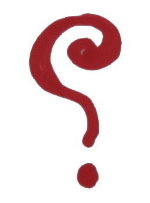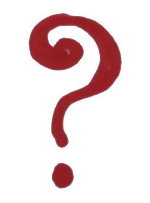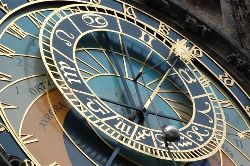THE
CATHAR
ZODIAC
Are these glyphs the 'Great Treasure' of the Cathars & Knights Templar?
DIGBY'S QUESTIONS
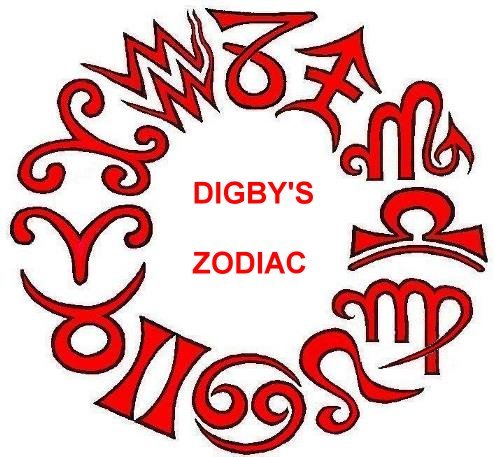
So. Who devised our modern glyphs way back in the Middle Ages? As far as we can see the 12 on the Prague Clock were a new circle, although a few can be traced back to early Greek astrology. (O. Medieval Zodiac Glyphs). Others raise questions. Why has Capricorn lost his horns and what exactly is Cancer?? And Leo? And why are there two 'M's?
These last two are the strongest lead to the Prague Clock, they being the first public example and us being unable to find any precedent. They must have been devised or kept secret before they appeared but why and by whom are unanswered questions. They only begin to make sense when we apply 'Poetic Logic', and then there emerges a strange version of Pre-Constantine Christianity and Pre-Jesus Corn Rites, and ending with an Orphic Full Stop.
So who Devised them?
We cannot be sure but the Albigensian Cathars were practising a similar sort of religion in which they believed fervently, and they were being threatened with extinction. There were also Cathars in the North who escaped the terrible Catholic purge, and their brothers the Knights Templar who had been given lands in Bohemia, and whose observances then went underground.
Digby's conjecture is that these modern glyphs emerged from this group of people, a default conjecture since we can find absolutely nothing written about the origin of this beautiful circle of hieroglyphs. And of course there is one glyph that doesn't fit into the idea. Pisces shows us a sublime symbol for a 'Union of Opposites', but the Cathars were pursuing the opposite: a separation of Heavenly Spirit from Satanic Flesh, leading to purity. However there were early Gnostic ideas of union, and they were picked up by Jung in modern times. We have followed that line with our Mysterium Conjunctus.
And ... as these are default conclusions may we wish Good Luck to anyone looking for proofs - or disproofs.
DIGBY'S SEARCH
Digby first came across these glyphs at the GSA in 1957 and was taken by their stark and elemental beauty. When he found in Britanica that they first appeared in the late Middle Ages he tried the Bodleian Library. They said that 'apart from confirming that the glyphs did apply to the Zodiac, they could be of no further help'. Later on they were very helpful. 'Too bad' thought Digby, but by this time he was using the glyphs to make little silver pendants and charms.
Digby's first stroke of luck was hearing about an early list of glyphs on an 11th. Century copy of an old Rhetorius manuscript. It showed all twelve signs but they looked garbled. Some were nothing like what we have today. That is when he began to realise he had a virgin field. He realised there was nothing really known about their origins and even less about some of the meanings. Like why the Lion, Crab, Goat and Fishes look out of place, and why the Virgin and Scorpio look so alike.
In the mid sixties there were changes in the air, and by this time Digby had set up a workshop for producing the goods, and a showroom for selling them. You could do that sort of thing in those days. He soon had a steady stream of customers and was able to live on what he produced. His best line was the twelve Signs of the Zodiac as pendants and charms and he must have sold thousands of them over the years.
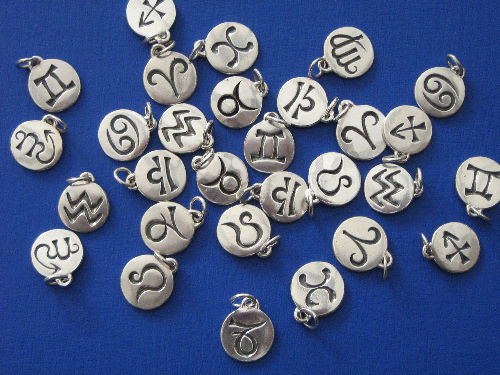
First off were two ladies who told him that Libra was 'flails over a thrashing floor', and the scales were in the Scorpion's tail. This led into growing corn and to Aleyin & Mot; 1500BC Phoenician twins, sower and reaper, sons of two gods and a clay tablet about it. The words on that tablet, spoken by Anat (the virgin in charge of the cornfields), reminded him of an illustration of John Barleycorn by a fellow GSA student: the ballad echoed the ancient clay tablet almost word for word:-------
'With her sickle she cleaves him'
'With her flails she thrashes him'
The farming idea made Aries the sower, Taurus for germination and the Twins for the shoots of wheat & tares maybe, and so it went on. Through Digby's showroom over the years came a stream of customers who must have been bored stiff by his endless topic of conversation. All were polite: the theologian who told him the glyphs had been banned by the church as soon as they surfaced, and a Keeper of Manuscripts who said '1340 I reckon. Pity about the 69', not to mention the psychologist who said the Twins were the most popular because 'nobody really liked being wholly good'.
In the mid 1990's it was becoming obvious to Digby that Astrology was not the number one motive for devising these glyphs, and that the heresy of dualism probably held the key. But the questions of 'Who?' and 'Why', were totally lost in the porridge.
Digby's wife came to the rescue. She was doing voluntary work in a charity shop and came home with a book written by Thomas Churton about the Gnostics, with a good lot about the Cathars. And the Bogomils. And Dualism.
Digby did his best to understand why the Catholic Church said that Cathar beliefs were heresy, but couldn't see much difference between them. One lot said a bad god made everything that was material, and a good god made everything that was spiritual to battle against it; and the other lot that a good god made both and something called Satan was trying to screw it up. Both sides said it was a battleground and life after death depended on life before death. Oh well.
Belief in two gods was called Dualism, and Digby wondered if the Templars logo of two knights on one horse signified something similar.

Now when Digby learned from Thomas Churton's book that the Bogomils had first brought Catharism up the Danube and on into Bohemia, and was also told that there was an old Clock in Prague that had a full circle of glyphs, he reckoned that the next step on his quest was obvious. His sister and brother-in-law organised the trip, and Digby said it was marvellous. Besides the clock, Prague has something exciting round every corner, and absolutely splendid beer by the jugful.
After a good look at this wonderful clock Digby noticed an anomaly that in the end led him to the meanings of two very difficult signs. He also learned of the clocks beginnings around 1410, and of the frightful Prague history that came five years later.
The 'Father of the Clock' was called Johannes Schindler who at the time was professor of mathematics at the Charles University. Jan Hus was the rector and, without mercy, he was burned at the stake in 1415 for heresies surrounding the Eucharist and Roman Catholic doctrine. This started a war between the Holy Roman Empire and the Bohemian Hussites. It lasted for nearly twenty years.
Five crusades were mounted against the Hussites, but, led by an unemployed one-eyed mercenary they resisted until in 1431 the Pope gave in. A settlement was reached in the city of Basle. By 1500 most Bohemians were Non-Catholic. Jan Hus is regarded as the first reformer of the Church. The Clock has remained intact to this day, and our thanks are due to Gems Publishing for this splendid photograph.
This trip to Prague was a turning point in Digby's quest. The anomalous Arabic numeral on it guided him to two glyphs designed as ciphers, and this put the whole twelve into a different light. And in Prague he noticed the strong focus of Greek Myths on all aspects of Astrology. Soon after they arrived home his wife got him a tattered paperback version of Robert Graves' great seminal work on the subject. From then on it was plain sailing but hard work.
Aries was the 'Ram with a Golden Fleece', and no ordinary beast. He had the power of speech and could reason. He embodied the Logos. What he was sowing was words. Language. You can't think without it. And Taurus made laws that depended on people understanding them. These glyphs are something to do with the birth of the modern mind. It took about five years to get the idea into shape and he tried selling it in the form of a little book together silver charms. Not a brilliant way to start. And now, after another two or three years of gleaning ideas and putting them into some kind of intelligible form Digby has called it finished. He's not adding any more to what he's got, and for what it's worth has added it to the Weird & Wonderful World Wide Web. It's taken 57 years and he's urging me to give talks about it.
His last input was about his ancestor Kenelm Digby whose weird collection of old manuscripts has been beautifully restored by the Bodleian Library and can now be seen on-line.
On one was a lonely glyph of Libra. To see it yourself Google 'DIGBY 83' and scroll down to Folio 53.
It will help if you can read Latin.
Now here's his story about that lively cavalier: When Kenelm was in Amsterdam he met up with Descartes and they talked about the new ways of thinking, scientific logic and all that. They thought that the whole universe might be a gigantic clock governed by cause and effect, and that reason would be able to answer all questions. They even questioned two beliefs. Descartes produced proof of God's existence, and Kenelm the immortality of the human soul. Um.
The Church probably liked that. It was damning the 'World, the Flesh and the Devil' and glorifying 'Goodness, Truth and Beauty', thus diverting huge energy into developing the mind. It had also started all the universities in Europe save one, but curiously it didn't like quite a lot of the understanding and knowledge that generated.
Julian Jaynes said that three thousand years ago most people were still using 'Magic Thought' because the
'Bicameral brain' we had then was incapable of proper logical reasoning,
and had not yet given us the identity we have today.
Looking back we can see that the mind we have today has been very hard won,
and after such a lengthy repression has resulted in endemic frustration and an unbalanced society ruled by greed and the lust for power.
Today we have Richard Dawkins telling us that we can abandon religion, and science will bring us paradise. Digby asks what hope does this brilliant new mind have in today's society. All that happens is that we do greed better.
But in those three thousand strife-ridden years, we have achieved a miraculous step forward. Plato gave us 'Looking through a glass darkly' and St Paul took up the theme and gave us 'The Divided Self'. Not long ago Jung said 'Modern man has lost his soul', and gave us the 'Union of Opposites'. Is this where the Petrine Church melds into the Johannine Church? In which case we're not quite finished with this old field yet. Maybe there's more to be done ...
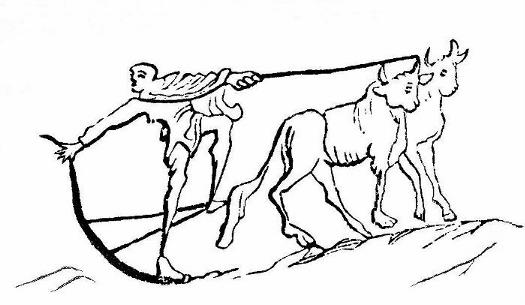
Sower, Dance & Plough drawings from the
Cotton Manuscript - British Library
![]()
Copyright © 2020 Cathar Zodiac Web Designs Bristol
